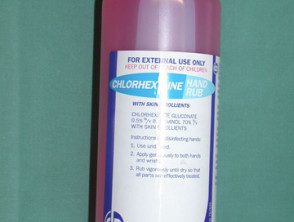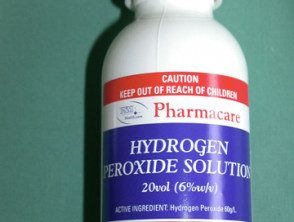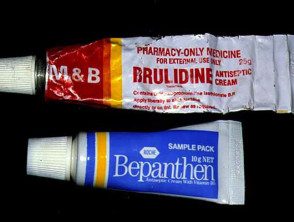What is an antiseptic?
An antiseptic is a chemical agent that slows or stops the growth of micro-organisms on external body surfaces and helps prevent infection. Antiseptics should be distinguished from antibiotics that destroy microorganisms within the body and disinfectants, which destroy microorganisms found in inanimate (non-living) objects. However, antiseptics are often called skin disinfectants.
Most chemical agents can be used as antiseptics and disinfectants. The purpose for which it is used is determined by its concentration. For example, hydrogen peroxide to 6% solution It is used to clean wounds, while the strongest solutions (> 30%) are used in the industry as a bleach and oxidizing agent.
Antiseptics

Antiseptic

Antiseptic

Types of antiseptic
Antiseptics can be classified according to their chemical structure. Commonly used antiseptic groups include alcohols, quaternary ammonium compounds, chlorhexidine and other diguanides, antibacterial dyes, chlorine and hypochlorites, inorganic iodine compounds, metals, peroxides and permanganates, halogenated phenol derivatives, and quinolone derivatives. The following table lists some of the agents within these groups.
Alcohol
- Ethyl alcohol 70%
- 70% isopropyl alcohol
- Used as a skin disinfectant.
Quaternary ammonium compound
-
Benzalkonium chloride
- Cetrimide
- Methylbenzethonium chloride
- Benzethonium chloride
- Ketalkonium chloride
- Cetylpyridinium chloride
- Dofanium chloride
- Domiphene bromide
- It is used as a skin disinfectant, irrigation and to preserve eye drops.
Chlorhexidine and another diguanide
- Chlorhexidine gluconate
- Chlorhexidine acetate
- It is used as a preoperative skin disinfectant, to treat wounds and to irrigate the bladder.
Antibacterial dye
- Proflavin Hemisulfate
- Triphenylmethane
- Shining green
- Violet glass
- Gentian violet
- It is used as a skin disinfectant and to treat wounds or burns.
Peroxide and permanganate
- Hydrogen peroxide solution
- Potassium permanganate solution
- Benzoyl peroxide
- Used as a wound cleaner, gargle and mouthwash, for irrigation and as a skin disinfectant.
Derived from halogenated phenol
- Chlorocresol
- Chloroxylenol
- Chlorophene
- Hexachlorophane / hexachlorophene (no longer available)
- Triclosan
- It is used as a skin disinfectant and in soaps and medicinal solutions.
Quinolone derivative
- Hydroxyquinoline sulfate
- Potassium hydroxyquinoline sulfate
- Chlorquinaldol
- Dequalinium chloride
- Diiodohydroxyquinoline
- It is used to treat wounds, in throat lozenges and as a skin disinfectant.
Diverse
- Burow's solution (aqueous solution of aluminum acetate)
- Bleach baths
Uses of antiseptic
The antiseptic is mainly used to reduce levels of microorganisms on the skin and mucous membranes skin and mucous membranes The mouth, nose and vagina harbor a large number of microorganisms (which are normally harmless).
- When the skin or mucous membranes are damaged or broken in surgery, an antiseptic is used to disinfect the area and reduce the chances of infection.
- People treating patients with wounds or burns should wash their hands with an antiseptic solution to minimize the risk of cross infection.
Antiseptics are used to:
- Handwashing: Chlorhexidine gluconate and povidone iodine solutions are often used in exfoliants and hand scrubs in hospital settings. Alcohol in concentrations> 60% will destroy pathogens like the SARS-CoV-19 virus.
- Preoperative skin disinfection: antiseptics applied to the operation site to reduce the flora of the resident skin. Caution should be exercised in the facial use of solutions containing chlorhexidine, as they can harm the eye and cause keratitis.
- Mucous membrane Disinfection: Antiseptic irrigations may be applied to the bladder, urethra, or vagina to treat infections or to clean the cavity before catheterization.
- Prevention and treatment of infected wounds and burns: antiseptic preparations are available on the counter from your pharmacist to treat minor cuts, abrasions and burns.
- Treatment of mouth and throat infections: Dequalinium Chloride has antibacterial and antifungal properties and is the active ingredient in antiseptic throat lozenges.
Are antiseptics effective and safe?
The effectiveness and complete safety of antiseptics have proven to be quite difficult to establish.
Due to concern about the potential for systemic Absorption, in December 2017, the United States Food and Drug Administration (FDA) ruled that 24 ingredients, including triclosan, are used in over-the-counter (over-the-counter) antiseptic products (such as hand washes, scrubs / scrubs). patient hands and antiseptics) preparations) intended for use by healthcare professionals in a hospital setting or other health care situations outside the hospital, are generally not recognized as safe and effective (often due to inadequate data). The 24 ingredients will be classified as new drugs that require regulatory approval for marketing beginning in December 2018. A decision on six other ingredients (benzalkonium chloride, benzethonium chloride, chloroxylenol, alcohol, isopropyl alcohol, and povidone-iodine) was deferred.
Precautions when using antiseptic
The strong antiseptic must be diluted before being applied to the skin, since concentrated products, including chlorhexidine, can cause chemical or severe burns. irritating Contact dermatitis. Prolonged contact with diluted antiseptic can also cause erosive contact dermatitis, as described with chlorhexidine-impregnated dressings.
The pharmacy-bought antiseptic should not be used for more than a week. Stop using the antiseptic and consult a doctor if:
- The affected area has not healed or improved.
- There is a large wound, deep cut, large burn or abrasion embedded with particles that cannot be washed
- The injury is due to a human or animal bite.
- One eye is injured.
Do not use antiseptics to treat sunburn or deep skin infections. Remember that the antiseptic only reduces microorganisms on the tissue surface and that antibiotics will be needed to treat the infection within the tissues.
People with allergies of any kind you should consult a doctor or pharmacist before using an over the counter antiseptic product. Some antiseptics can irritate the skin and cause allergic contact dermatitis. Chlorhexidine has been reported to rarely cause anaphylaxis.
What about antibacterial soap?
In September 2016, the United States Food and Drug Administration (FDA) issued a final document. rule establishing that free sale (military cadet corps) consumer antiseptic washing products containing certain active ingredients can no longer be marketed. Nineteen of these are included, including triclosan and triclocarban. Regulators in other countries can follow similar resolutions. The reasons include:
- There is no scientific evidence that antibacterial washing is better than soap and water at preventing the spread of germs.
- Domestic use of antibacterial ingredients can do more harm than good in the long run, such as promoting bacterial resistance (see MRSA).
Hand sanitizer Containing at least 60% of alcohol can be used, if soap and water are not available. Emollients They are recommended after use if the hands are dry or develop contact dermatitis due to the use of antiseptics.

